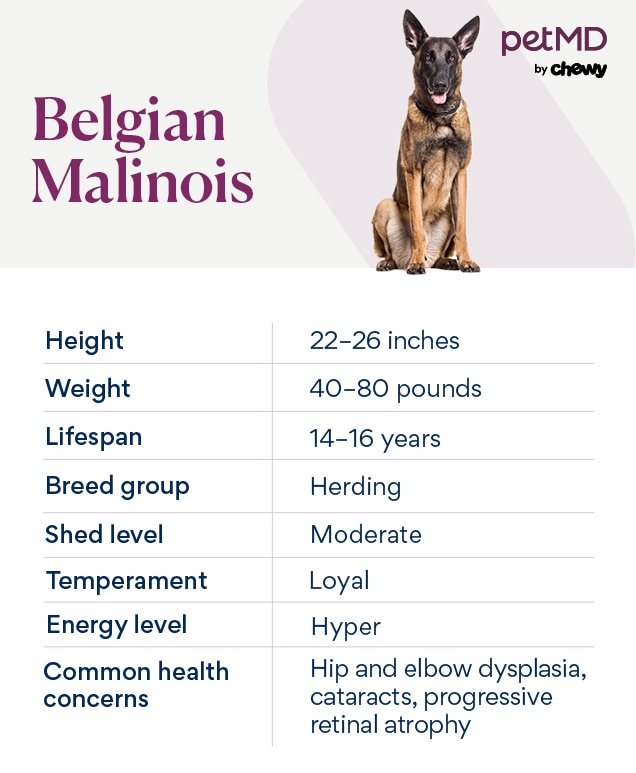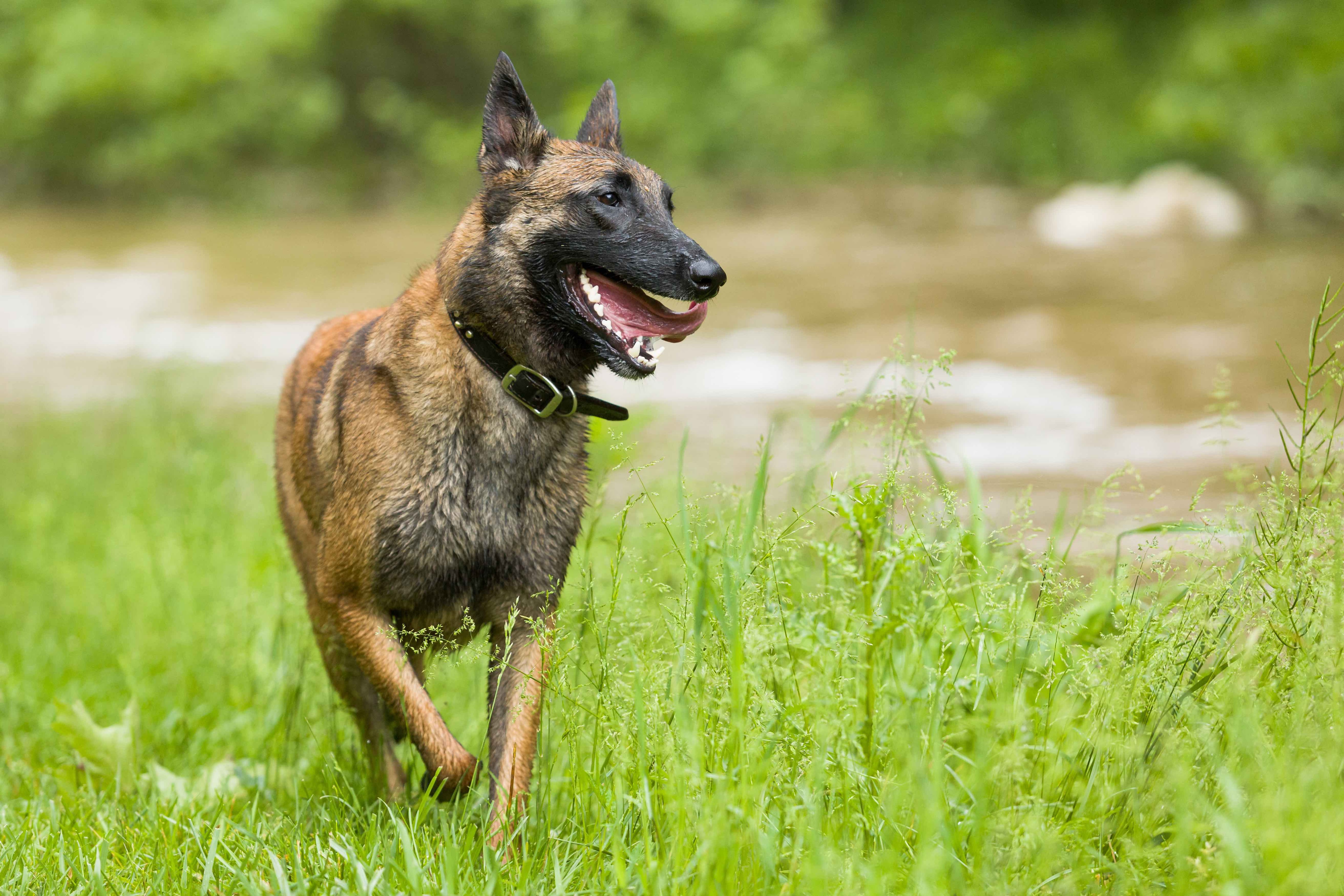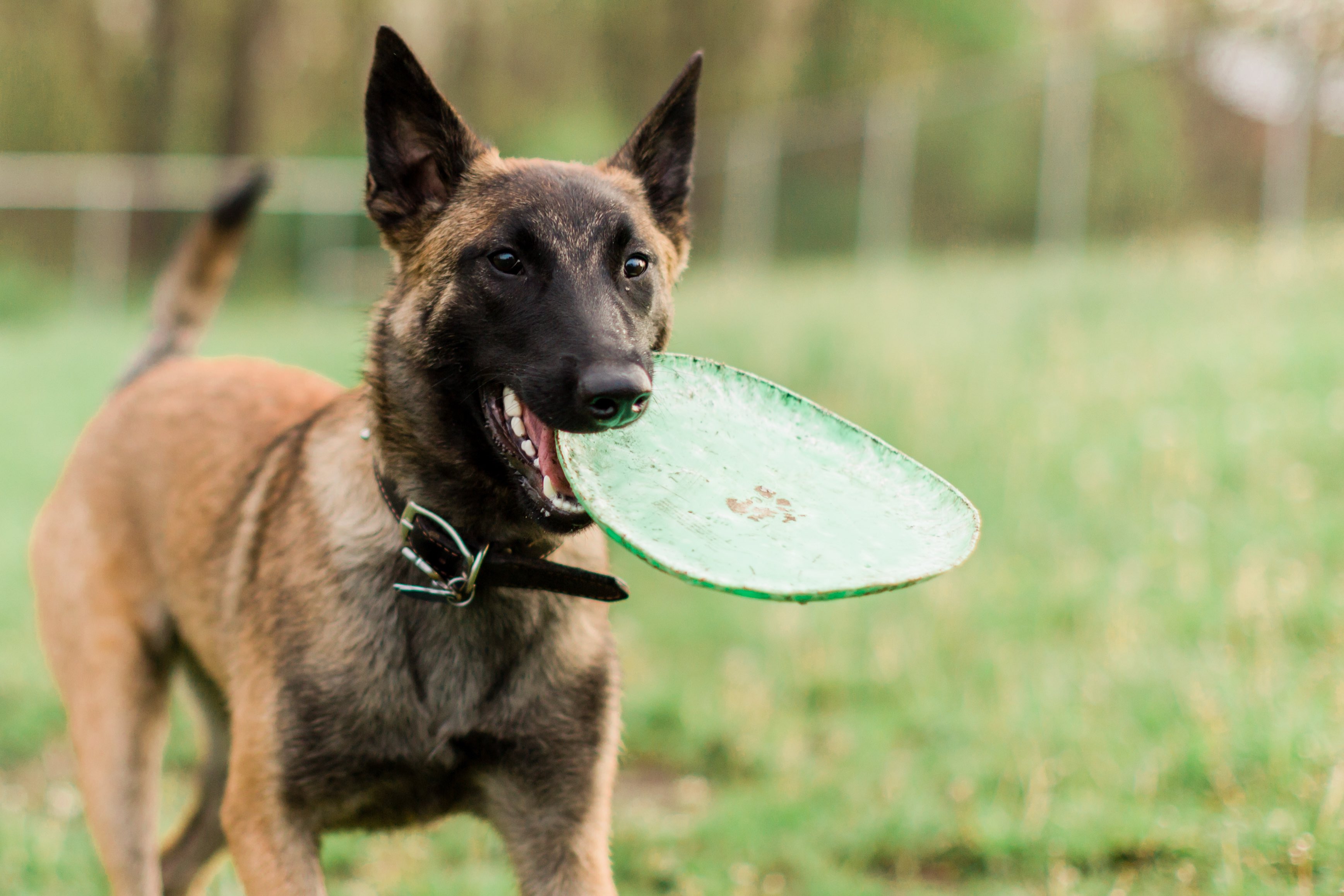Belgian Malinois
Belgian Malinois are one of the most proud, intelligent, and hardworking dog breeds in existence. These traits can make them phenomenal pets—if they’re in the right household with an active and experienced pet parent.
Belgian Malinois were first bred near the city of Malines in Belgium, where they got their name. They were originally bred to be herders, but their trainability and drive led them into several other careers, including protection, search and rescue, and bomb and drug detection. This means that Belgian Malinois do best in a house where they have a job to perform, such as agility, tracking, and/or obedience.
When fully grown, male Belgian Malinois are typically 24–26 inches tall and 60–80 pounds, while females stand about 22–24 inches tall and weigh 40–60 pounds.
Caring for a Belgian Malinois

Belgian Malinois dogs are incredibly loyal and smart, but they’re also high-energy and need a lot of exercise and stimulation. Daily walks are simply not enough for this breed.
Typically, Belgian Malinois need more than 40 minutes of exercise per day. This makes them great running, hiking, and biking companions. They’re also excellent at agility, tracking, herding, and obedience competitions.
However, when Belgian Malinois don’t get enough exercise or mental stimulation, they often start to exhibit destructive behaviors to keep themselves entertained.
Belgian Malinois Health Issues
The Belgian Malinois lifespan is typically 10–14 years. Compared to many breeds, these dogs don’t have a lot of health concerns, especially if they were bred by a responsible breeder.
That said, Belgian Malinois are predisposed to a few medical issues. Pet insurance might be a smart investment when you bring home your Belgian Malinois puppy.
Elbow and Hip Dysplasia
Belgian Malinois are predisposed to elbow dysplasia and hip dysplasia, both of which are hereditary structural joint conditions. These can cause joint pain and arthritis. Signs to monitor for at home include:
-
Limping with no history of trauma
-
Popping sounds from the joints
-
“Bunny hopping” when running
-
Difficulty standing
-
Abnormal sitting positions
-
Difficulty getting on/off furniture, going upstairs, and getting into cars
Before bringing home a Belgian Malinois puppy, make sure your breeder had the pup’s parents tested for these conditions. If your pet does end up with dysplasia, treatment can range from pain medication and joint supplements to surgery.
Cataracts
Belgian Malinois are also predisposed to cataracts, which is a progressive hardening of the eye lens. This causes the eye to become cloudy, eventually leading to blindness. If this does occur, surgery can be performed by a veterinary ophthalmologist to replace the lens.
Progressive Retinal Atrophy (PRA)
The retina is a layer of cells at the back of the eye that allows you to see light. “Atrophy” means wasting away over time. Simply put, progressive retinal atrophy (PRA) causes retina deterioration, leading to blindness.
Fortunately, this disease is not painful, so the primary signs are what you may expect in an animal going blind: bumping into things, difficulty catching treats, tripping over curbs or stairs, etc.
Unfortunately, there is no treatment for PRA, but a good Belgian Malinois breeder will screen the parents so the condition doesn’t get passed on to their offspring.
What To Feed a Belgian Malinois

Belgian Malinois don’t have very specific dietary requirements. In general, they do well on any high-quality dog food with a veterinarian’s supervision. Just make sure your pet is on a diet that is appropriate for their age—puppy food should be given until your pet is at least 1 year old before switching to adult dog food.
How To Feed a Belgian Malinois
Feeding schedules in dogs are determined on a dog-by-dog basis. But, in general, Belgian Malinois should be fed twice daily—once in the morning and once in the evening. Belgian Malinois puppies may need to eat more frequently, up to four times every day.
Always talk to your veterinarian to determine what is best for your pet.
How Much Should You Feed a Belgian Malinois?
How much to feed your dog depends on many factors, including your pup’s age, activity level, and size. The back of the bag may be a good place to start, as it has a chart based on current age and weight. Recheck this guide frequently, as puppies grow rapidly and their calorie needs change.
Talk to your veterinarian to determine the right amount of food for your pet.
Nutritional Tips for a Belgian Malinois
In an otherwise healthy pet, if they are on a high-quality complete and balanced diet, they shouldn’t need any nutritional supplements unless directed by your veterinarian.
Behavior and Training Tips for Belgian Malinois

Belgian Malinois require an extensive amount of training to help minimize any behavioral issues and keep their mind engaged. Training and socialization should start as early as possible and continue throughout their life to provide them with adequate mental stimulation.
Belgian Malinois Personality and Temperament
Belgian Malinois are incredibly loyal dogs and tend to form an unbreakable bond with their human. They are not the type of dog that can just be left in the backyard to entertain themselves. Ultimately, they want nothing more than to spend as much time with you as possible.
They are also a very high-energy breed that needs lots of exercise and stimulation. Ideally, Belgian Malinois should get more than 40 minutes of exercise per day—with you by their side. Some things they love include herding, agility, search and rescue, and tracking.
Belgian Malinois Behavior
When Belgian Malinois don’t get enough exercise or stimulation, they often start to exhibit destructive behaviors, such as:
-
Destroying furniture, rugs, carpet, curtains, plants, etc.
-
Chewing personal items (shoes, clothes, etc.)
-
Gnawing through doors and window frames, or breaking windows
Ideally, Belgian Malinois should get more than 40 minutes of exercise per day—with you by their side.
A well-trained and socialized Belgian Malinois can be a great family dog, but one of their inherent traits is being watchful over their family. While this can certainly have its benefits, it can also make it difficult to have guests or strangers come into the house. Again, training and socialization should begin when your Belgian Malinois puppy is young and continue throughout their life.
Belgian Malinois also have a high prey drive, making them extremely interested in moving objects. This can lead to them chasing after cars, other animals, and even children. They may also try to use their herding skills to round up toddlers and small children. Always supervise interactions between kids and dogs of all breeds.
Belgian Malinois Training
Belgian Malinois are incredibly smart dogs, which makes them eager (and fast!) learners.
It’s recommended that Belgian Malinois puppies are trained by a professional who is familiar with the breed. A seasoned trainer will be able to help train your dog for jobs that can stimulate their mind—a critical aspect for this breed.
These jobs are often seen as fun activities for them, and it’s important for you to be involved in the training process, as it will increase your pet’s bond with you.
Fun Activities for a Belgian Malinois
-
Herding
-
Tracking
-
Obedience
-
Sledding
-
Agility
-
Therapy assistance
Belgian Malinois Grooming Guide

Unlike some other Belgian dogs, like the long-haired Belgian Sheepdog, Belgian Malinois pups have a short, waterproof coat, making them easy to care for.
They do shed seasonally twice a year, so don’t be surprised if you see more hair on the floor in the fall and spring. This “blowout” of their undercoat typically lasts two to three weeks and helps better prepare their body for the coming season (winter or summer). As with all dogs, their nails should be trimmed regularly.
Skin Care
Belgian Malinois have waterproof coats that protect the skin. Like any dog, they can develop skin allergies, but this is uncommon. Due to their active lifestyle and love of the outdoors, year-round heartworm, flea, and tick prevention is highly recommended.
Baths should be performed as needed but typically not more than once per month to avoid drying out their skin. Dogs should always be bathed in dog-specific shampoos tailored for their skin and pH, and not human shampoo or body wash products.
Coat Care
Simply brushing their coat occasionally with the right dog brushes (a medium-bristle brush, a rubber grooming mitt, or a hound glove will work) is adequate for keeping your Belgian Malinois healthy. This promotes new hair growth and distributes oils throughout the coat.
Eye Care
Belgian Malinois are extremely active dogs who can sustain a scratch to the eye or other injuries. If your dog’s eyes are red or your pup is rubbing at them, check with your veterinarian.
And, given their breed risk for PRA and cataracts, check with your veterinarian immediately if you have concerns about your pet’s vision.
Ear Care
The Belgian Malinois’ ears should be checked monthly for signs of infection, such as excessive ear wax, redness, and inflammation. For an otherwise healthy Belgian Malinois, clean their ears once a month with a vet-recommended ear cleaner or ear flush.
Considerations for Pet Parents
There are several things that need to be considered before bringing a Belgian Malinois into your home. It’s important to assess the following to determine whether this breed is right for you:
-
Are you able to provide this high-energy breed with the physical and mental outlets they need?
-
Are you able to invest in early, consistent training by a professional?
-
Will your dog have a job to do to keep them busy and engaged?
If the answer to these questions is yes, you may be ready for this high-energy dog from Belgium.
Belgian Malinois FAQs
Is a Belgian Malinois a good family dog?
Belgian Malinois are incredible, high-energy animals that can make excellent family dogs in the right household. These dogs can be the wrong choice for the average household because of their greater-than-average need for mental and physical exercise.
Are Belgian Malinois smart dogs?
Belgian Malinois are incredibly intelligent animals, making them easy to train and highly successful working dogs. They’re fast and engaged learners, making training not only fun, but critical for their mental well-being.
How much does a Belgian Malinois cost?
The Belgian Malinois price can vary greatly depending on the bloodlines of the dog, the dog’s age, and whether the dog has received specialized training. For dogs that have been trained, the level of training further dictates the cost.
On average, a purebred Belgian Malinois puppy with American Kennel Club-registered parents will cost around $2,000–$3,500. However, this can vary widely depending on location and the lineage of the puppy.
What’s the difference between Belgian Malinois vs. German Shepherds?
Belgian Malinois are dogs that look like German Shepherds. Given the similar coat patterns and inherent personality traits that come with herding breeds, it’s easy to see how Belgian Malinois and German Shepherds could be confused with one another. However, there are a few key differences between them.
-
Belgian Malinois were bred in Belgium, while German Shepherds were bred in Germany.
-
Both breeds are similar in height, but Belgian Malinois typically weigh less than German Shepherds. Belgian Malinois typically weigh 40–80 pounds, while German Shepherds can weigh 50–90 pounds.
-
Belgian Malinois colors are fawn with a black mask and ears, with a short coat. German Shepherds have slightly longer fur with a black and tan or black and silver coat and a black saddle of fur over their back.
-
Both breeds are high energy and need a job to do to help stimulate their mind and keep them happy. But, in general, Belgian Malinois tend to have a slightly higher energy level than German Shepherds.
Featured Image: iStock/Sansargo
